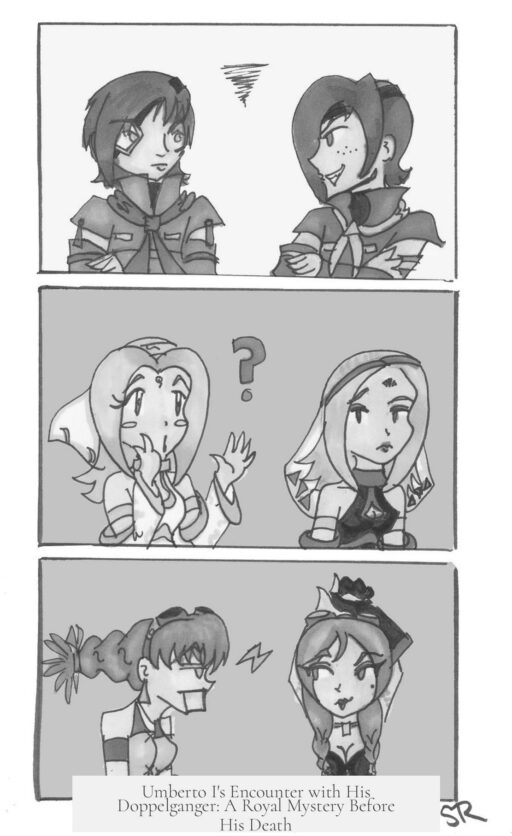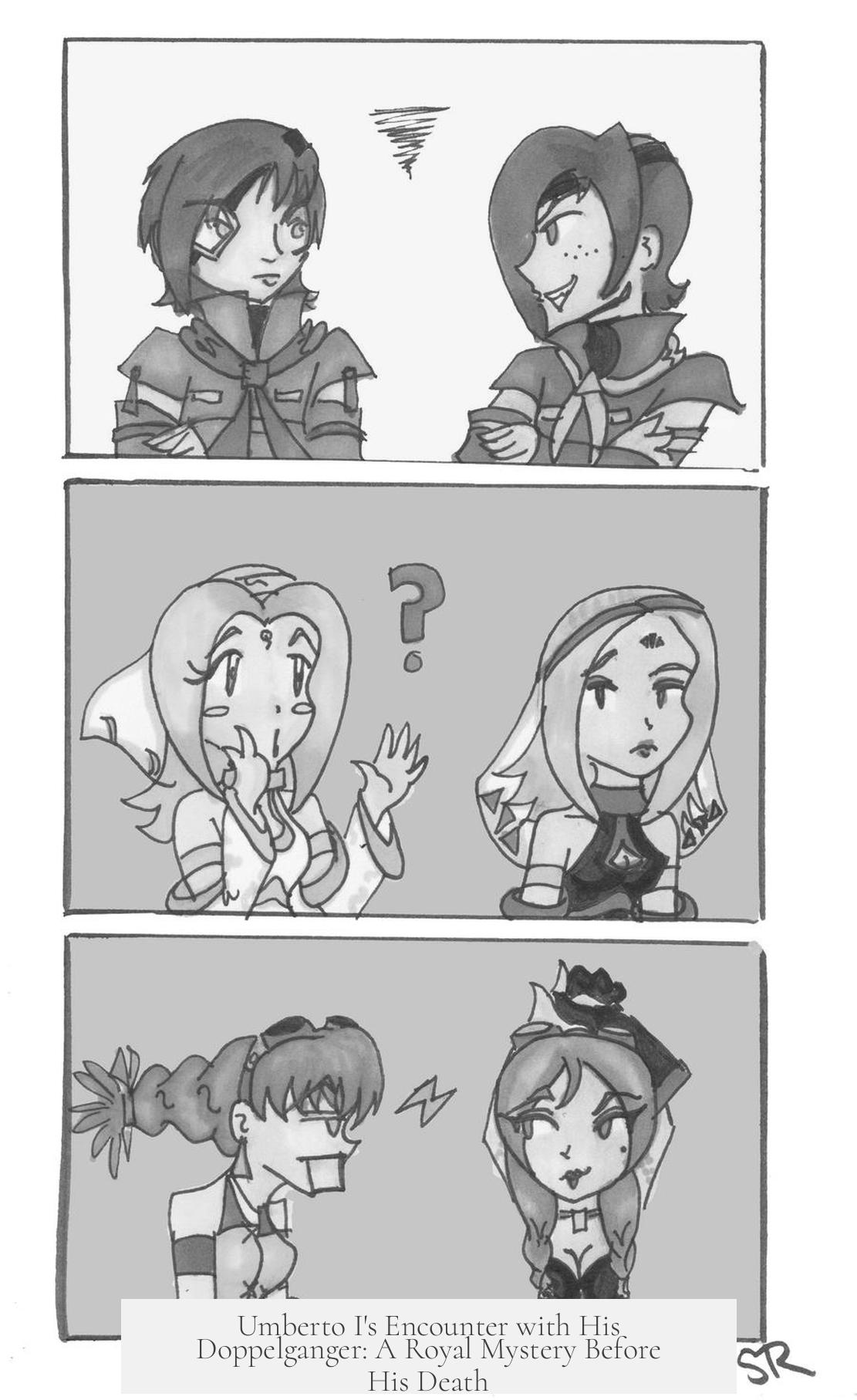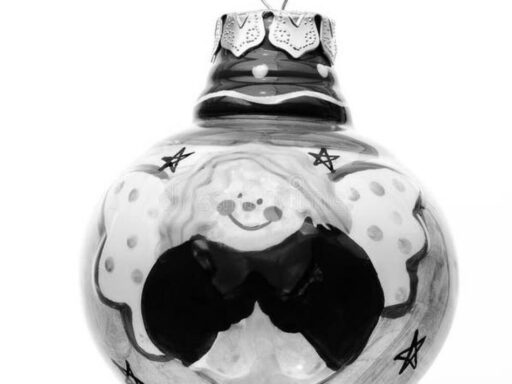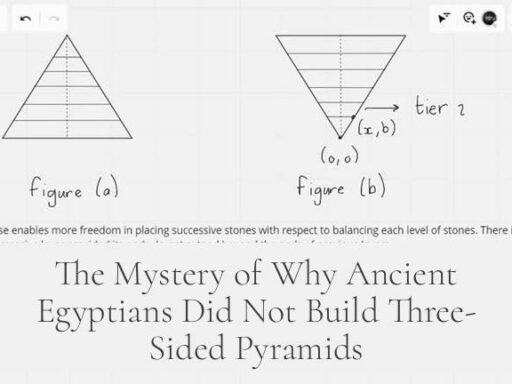There is no confirmed evidence that Umberto I, King of Italy, met his doppelganger shortly before his death. The story originates from anecdotal reports, mainly from Emilio Ponzio Vaglia, the King’s aide-de-camp, who was present during the King’s last hours. However, the veracity of this tale remains doubtful and probably exaggerated due to superstition.
The anecdote about the King encountering his double the night before his assassination is traced back to a 1936 book by Filippo Crispolti, as quoted by historian Luciano Regolo in a biography of Queen Margherita. Ponzio Vaglia reportedly remembered dining with Umberto I when they both noticed a man who resembled the King. The story suggests they found the resemblance striking, but the narrative that this meeting was ominous or portentous likely grew in retelling.
Regolo expresses skepticism about the anecdote’s truth. He points out that close relations and witnesses often interpret ordinary events as mysterious signs before tragic outcomes. The resemblance between the King and the restaurant owner might have been real, especially considering Umberto I’s distinctive large moustache, but the idea that this encounter reflected a deeper supernatural or fateful significance lacks support.
Interestingly, historical records show several doppelganger stories involving Umberto I during his lifetime. A notable example was reported by a French journalist in 1901 in Le Rappel. This report described Mr. Bertolani, a photographer from Salerno, who closely resembled the King. Bertolani was proud of this similarity and enhanced it by styling his moustache and posture similarly. His appearance caused confusion among soldiers, who feared encountering the “specter” of the murdered monarch. One sentry even dropped his rifle in fright and was replaced. This tale highlights how common doppelganger stories were at that time.
The Bertolani story and other similar accounts were partly driven by the increasing circulation of photographs of royals in newspapers. Visual likenesses became common knowledge, encouraging the public to spot doubles in everyday life. This cultural phenomenon explains why multiple look-alike stories existed for high-profile figures like Umberto I, rather than suggesting true supernatural doubles.
The tale linking Umberto I’s doppelganger meeting directly to his assassination likely grew in popularity from its inclusion in English-language media. It notably appeared in the 1954 edition of Ripley’s Believe It or Not, a series known for sensational and curious stories. This publication helped cement the anecdote in popular imagination, even though its original 1936 source was less accessible and its accuracy uncertain.
| Aspect | Details |
|---|---|
| Anecdote Source | Emilio Ponzio Vaglia, based on a 1936 book by Filippo Crispolti |
| Veracity | Doubted by historian Luciano Regolo; possibly exaggerated |
| Similar Stories | Mr. Bertolani, photographer look-alike in 1901 Naples; caused soldier confusion |
| Context | Doppelganger stories common due to widespread photographs of royals |
| Popularization | English exposure via Ripley’s Believe It or Not (1954) |
In summary, the story that Umberto I met his doppelganger before his death is likely a blend of fact and folklore. The King and his aide-de-camp probably noticed a man resembling Umberto I. However, the dramatic interpretation of this event seems to be a product of superstition and later embellishment. Other unrelated doppelganger tales existed simultaneously, reflecting a cultural fascination with doubles in the early 20th century rather than a singular, meaningful encounter.
- Umberto I’s doppelganger story originates from a 1936 memoir but is not fully verified.
- Historian Luciano Regolo doubts the anecdote’s accuracy, suggesting exaggeration.
- Similar stories of look-alikes, like photographer Bertolani, were popular around the same time.
- Doppelganger tales grew partly due to widespread publication of royal photographs.
- The King’s alleged encounter was popularized in English by Ripley’s Believe It or Not in 1954.
Did Umberto I, King of Italy, Meet His Doppelganger Shortly Before His Death?
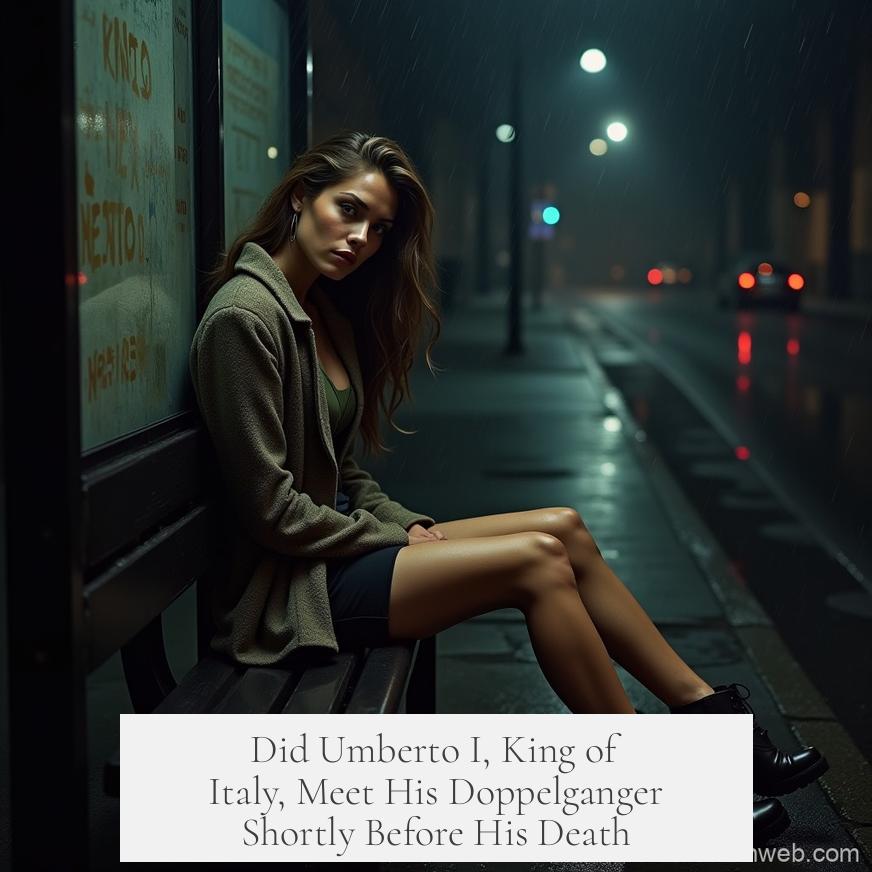
Short answer: Yes, the story exists that King Umberto I of Italy met a man who looked strikingly like him shortly before his assassination, but the truth is wrapped in layers of rumor, superstition, and maybe a bit of creative memory.
Now that we’ve got that out of the way, let’s dive into this kingly mystery. How real is this doppelganger tale? What’s the source? And could it just be a fancy ghost story dressed up as history?
An Anecdote Rooted in History and Hearsay
The story that King Umberto I encountered his double comes from a recent biography of Queen Margherita, penned by Luciano Regolo. Regolo’s source? A 1936 book of souvenirs titled Corone e porpore by Filippo Crispolti. Unfortunately, Regolo never laid eyes on Crispolti’s original text — so we’re working through a fog here.
The key witness—and potential storyteller—is Emilio Ponzio Vaglia, the King’s aide-de-camp. This man wasn’t just any courtier; he dined with King Umberto the night before the king was assassinated and was standing right by him when tragedy struck. Talk about being in the wrong place at the wrong time.
“Regolo says that the anecdote appears to come from Emilio Ponzio Vaglia, the King’s aide-de-camp who dined with him that night and who was at Umberto’s side when he was killed the next day.”
The Skeptic’s Corner: Could It Be a Tall Tale?
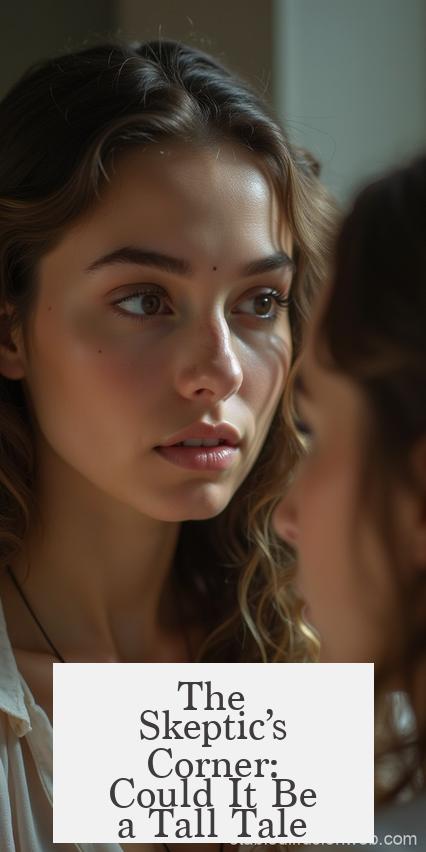
Is this story trustworthy? Regolo himself isn’t convinced. He highlights a psychological quirk: friends, family, and close aides often see “signs” of tragedy before it unfolds. It’s a classic superstition – humans love to find mysterious omens when a loss hits suddenly.
So, what’s likely here? Most experts agree Umberto and Ponzio Vaglia probably noticed a resemblance between the King and a restaurant owner they encountered. Great, the king bumps into a lookalike – not exactly headline news, right? But as the years passed, the tale might have ballooned into a spooky prophecy, with embellishments piled on like layers of tiramisu.
“We do not know how much this episode is true or instead exaggerated by Ponzio Vaglia or whoever on his behalf, because of that typical, recurring, somewhat superstitious sentiment that often drives friends and relatives, to pick up, in the days immediately preceding someone’s unexpected end, mysterious signs of tragic destiny.”
The man himself, King Umberto I, was known for distinctive features—a large, sweeping moustache and a regal presence that made any resemblance stand out dramatically. But that doesn’t mean every doppelganger tale is gospel.
More Than One Doppelganger? The Salerno Photographer Story
Interestingly, Umberto I had at least one other documented look-alike: Mr. Bertolani, a photographer in Salerno. A French journalist wrote about this in 1901 in Le Rappel. Bertolani was so proud of his resemblance that he styled his moustache and carriage to mimic the King’s.
This went beyond mere vanity when soldiers mistook Bertolani for the ghost of the assassinated monarch. Imagine this: soldiers dropping rifles, shouting for help, all because of a moustache and a smile.
“On seeing the photographer he thought he was in the presence of the spectre of the murdered monarch. Fearful, he dropped his rifle and shouted for help. He was relieved from his post.”
Another officer was also fooled until a bike-riding officer finally confirmed Bertolani was flesh and blood, not a vampire king.
The notoriety of the Bertolani brothers—three mustachioed photographers famous in Salerno—shows doppelganger stories were common. Newspapers spread photos far and wide, making the public keenly aware of their rulers’ faces and thus more prone to spotting doubles.
Why So Many Doppelganger Tales in That Era?
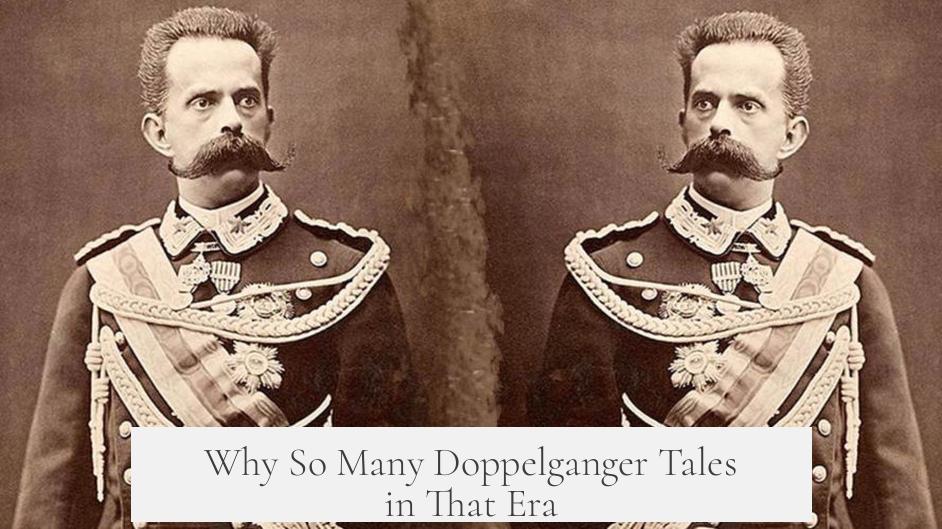
Turns out, the early 1900s were ripe for stories about royal look-alikes. Newspapers, now printing photographs regularly, gave everyone visual access to monarchs and presidents. People suddenly noticed similarities that might otherwise have gone unremarked.
It was a curious mix of media technology and human imagination—equal parts fascination and eerie coincidence—and Umberto I’s image surely carried a strong imprint in the public consciousness.
“It was just one of several doppleganger stories at that time: there was a flurry of princes and presidents look-alikes in Europe, perhaps due to the wide dissemination of photographs in newspapers that made people even more aware than before of how their rulers looked.”
How Did This Story Become Legendary?
The Umberto doppelganger tale, especially related to his death, may owe much of its fame to the 1954 edition of Ripley’s Believe It or Not. Ripley’s has a knack for selecting odd, unbelievable stories and imprinting them forever in popular culture.
So, if you hear about Umberto meeting his ghostly twin right before a fatal day, chances are you’re hearing a Ripley-fueled legend, not a cold hard fact.
“If the Umberto doppelganger story appeared in 1936, it may have been popularized when it was published in English in the Ripley’s Believe it or Not series ([1954 edition]), which seems to be the basis for the version circulating today.”
What Can We Take Away from This Royal Doppelganger Drama?
- Real encounter — likely: King Umberto and aide Emilio Ponzio Vaglia probably noticed a man with an uncanny resemblance. This part is plausible and not extraordinary.
- Embellishments — highly likely: The more eerie and prophetic details likely bloomed in retellings, fueled by grief and superstition.
- Cultural context — key: Early 20th-century fascination with photographic images led to an abundance of doppelganger stories.
- Similar tales — common: The story of photographer Bertolani shows Umberto’s likeness was a known phenomenon with humorous consequences.
So, did Umberto I meet his doppelganger? Probably yes. Was it some spooky omen? That part belongs to legend and human imagination. But here’s a fun thought: if a king bumps into his double before meeting his end, does that mean we should all check the mirror twice before stepping out? It’s history and a bit of human nature, wrapped together.
Next time you catch a glimpse of someone who looks just like you, ask yourself: is this the start of a ghostly story or just the universe messing with your head? Either way, you’re in good company with King Umberto.
